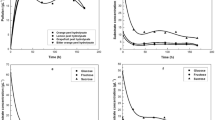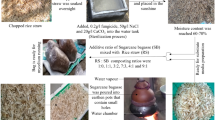Abstract
The cultivation of Pleurotus eryngii is increasing rapidly in China due to its nutritional and medicinal importance, excellent flavor, and long shelf life; therefore, cheaper and locally available alternative substrates are urgently needed. Experiments were performed to investigate the use of alternative substrates for P. eryngii cultivation. Korshinsk peashrub (Caragana korshinskii Kom.), a perennial shrub, was included in the substrate at varying rates to substitute for the sawdust and sugarcane bagasse (21/38 and 21/35%, respectively) in the typical substrate. The cultivation substrate including 38% Korshinsk peashrub did not significantly affect linear mycelial growth. The fruit body yield (247.3 g/bag) and biological efficiency (70.66%) achieved by using this substrate were significantly higher than those achieved using the control substrate (229.6 g/bag and 65.59%). Crude polysaccharide content was highest (6.12%) in the mushroom grown on 38% Korshinsk peashrub substrate; in this mushroom, crude polysaccharide content was increased by 70.47% compared with that of the mushroom grown on the control substrate (3.59%). These results reveal that supplementing the substrate in which P. eryngii is grown with Korshinsk peashrub can improve polysaccharose accumulation by P. eryngii. The findings described above reveal that Korshinsk peashrub is an efficient, cost-effective, and promising substrate additive that can improve P. eryngii quality and yield while largely substituting for sawdust and sugarcane bagasse.

Similar content being viewed by others
References
Jeznabadi, E.K., Jafarpour, M., Eghbalsaied, S.: King oyster mushroom production using various sources of agricultural wastes in Iran. Int. J. Recycl. Organ. Waste Agric. 5, 1–8 (2016)
Zhao, Y., Li, P., Hu, H., Wang, Y., Sun, Y., Huang, K.: Postharvest decay of the cultivated mushroom Pleurotus eryngii caused by Lactococcus lactis subsp. lactis. J. Plant Pathol. 95, 247–253 (2013)
Ohga, S., Royse, D.J.: Cultivation of Pleurotus eryngii on umbrella plant (Cyperus alternifolius) substrate. J. Wood. Sci. 50, 466–469 (2004)
Im, C.H., Kim, M.K., Kim, K.H., Sun, Y.K., Lee, S.T., Heo, J.Y., Kwon, J.H., Dong, S.K., Ryu, J.S.: Breeding of king oyster mushroom, Pleurotus eryngii with a high yield and earliness of harvest trait and its sensory test. Kor. J. Mycol. 41, 91–96 (2013)
Rodriguez Estrada, A.E., Royse, D.J.: Yield, size and bacterial blotch resistance of Pleurotus eryngii grown on cottonseed hulls/oak sawdust supplemented with manganese, copper and whole ground soybean. Bioresour. Technol. 98, 1898–1906 (2007)
Okano, K., Fukui, S., Kitao, R., Usagawa, T.: Effects of culture length of Pleurotus eryngii grown on sugarcane bagasse on in vitro digestibility and chemical composition. Anim. Feed. Sci. Technol. 136, 240–247 (2007)
Moonmoon, M., Uddin, M.N., Ahmed, S., Shelly, N.J., Khan, M.A.: Cultivation of different strains of king oyster mushroom (Pleurotus eryngii) on saw dust and rice straw in Bangladesh. Saudi J. Biol. Sci. 17, 341–345 (2010)
Naraian, R., Sahu, R.K., Kumar, S., Garg, S.K., Singh, C.S., Kanaujia, R.S.: Influence of different nitrogen rich supplements during cultivation of Pleurotus florida on corn cob substrate. Environmentalist 29, 1–7 (2009)
Ryu, J.S., Min, K.K., Im, C.H., Shin, P.G.: Development of cultivation media for extending the shelf-life and improving yield of king oyster mushrooms (Pleurotus eryngii). Sci. Hortic. 193, 121–126 (2015)
Stajić, M., Vukojević, J., Duletićlausević, S.: Biology of Pleurotus eryngii and role in biotechnological processes: a review. Crit. Rev. Biotechnol. 29, 55 (2009)
Sun, F., Xing, Z.: Research on advantage and new use of Korshinsk peashrub resources. Agric. Sci. Technol. 15(4), 709–712 (2014)
Cheng, J.: Spatial-temporal variability of Caragana korshinskii vegetation growth in the Loess Plateau. Sci. Silvae Sinicae 49, 14–20 (2013)
Qu, J.S., Zhang, L.J., Feng, H.P., Yang, D.Y.: Status of development and utilization of biamass caragana in Ningxia horticultural substrate cultivation. North. Horticul. 23, 198–201 (2013)
Zhu, X.Q., Wang, Y.H., Sun, G.Q.: A preliminary study on the cultivation of Pleurotus citrinipileatus by Korshinsk peashrub powder. Inner Mongolia Agric. Sci. Technol. 1, 68–69 (2006)
Liu, P.R., Song, N.P., Su, J.Y., He, Y.X., Niu, Y.P.: Selecting formula For edible fungi Caragana intermedia powder as main cultivation material. Nor. Horticul. 24, 168–170 (2012)
Yang, Y.H., Li, C.P., Nie, J.J., Xing, H.J., Li, Z.B., Wang, Z.: A study on the cultivation of Pleurotus nebrodensis var. tuoliensis on Korshinsk peashrub powder with ground corncobs. Shi Yong Jun 4, 20–22 (2011)
Goering, H.K., Soest, P.J.V.: Forage fiber analyses (apparatus, reagents, procedures, and some applications). In: USDA Agriculture Handbook. US Dept. of Agriculture, Washington, DC (1991)
Bellettini, M.B., Fiorda, F.A., Maieves, H.A., Teixeira, G.L., Ávila, S., Hornung, P.S., Júnior, A.M., Ribani, R.H.: Factors affecting mushroom Pleurotus spp. Saudi J. Biol. Sci. (2016). https://doi.org/10.1016/j.sjbs.2016.12.005
Naraian, R., Narayan, O.P., Srivastava, J.: Differential response of oyster shell powder on enzyme profile and nutritional value of oyster mushroom Pleurotus florida PF05. Biomed. Res. Int. (2014). https://doi.org/10.1155/2014/386265
Zhang, R.Y., Hu, D.D., Ma, X.T., Li, S.G., Gu, J.G., Hu, Q.X.: Adopting stick spawn reduced the spawn running time and improved mushroom yield and biological efficiency of Pleurotus eryngii. Sci. Hortic. 175, 156–159 (2014)
Vol., N.: Official methods of analysis of AOAC International (16th edn.). In: Patricia Cunniff, A. (ed.) Trends in Food Science and Technology: An Official Journal of the European Federation of Food Science and Technology (EFFoST) and the International Union of Food Science and Technology (IUFoST), vol. 6. Elsevier, Cambridge (1995)
Jonathan, S., Okon, C., Oyelakin, A., Oluranti, O.: Nutritional values of oyster mushroom (Pleurotus ostreatus)(Jacq. Fr.) Kumm. Cultivated on different agricultural wastes. Nat. Sci. 10(9), 186–191 (2012)
Chang, S.T., Hayes, W.A., Chang, S.T., Hayes, W.A.: The Biology and Cultivation of Edible Mushrooms. Academic Press, San Diego (1978)
Kurtzman, R.H.: Nutrition of Pleurotus sapidus: effects of Lipids. Mycologia 68, 286–295 (1976)
Oyetayo, V.O., Ariyo, O.O.: Micro and macronutrient properties of Pleurotus ostreatus (Jacq: Fries) cultivated on different wood substrates. Jordan J. Biol. Sci. 6, 223–226 (2013)
Philippoussis, A.N., Diamantopoulou, P.M., Zervakis, G.I.: Correlation of the properties of several lignocelulosic substrates to the crop performance of the shiitake mushroom Lentinula edodes. World J. Microbiol. Biotechnol. 19, 551–557 (2003)
Skalicka-Woźniak, K., Szypowski, J., Łoś, R., Siwulski, M., Sobieralski, K., Głowniak, K., Malm, A.: Evaluation of polysaccharides content in fruit bodies and their antimicrobial activity of four Ganoderma lucidum (W Curt.: Fr.) P. Karst. Strains cultivated on different wood type substrates. Acta Soc. Bot. Pol. 81, 17–21 (2012)
Hoa, H.T., Wang, C.L., Wang, C.H.: The effects of different substrates on the growth, yield, and nutritional composition of two oyster mushrooms (Pleurotus ostreatus and Pleurotus cystidiosus). Mycobiology 43, 423 (2015)
Acknowledgements
The authors are thankful to the Fundamental Research Funds for Central Non-profit Scientific Institution (No. 2014-21), the Special Fund for Agro-Scientific Research in the Public Interest, China (No. 201503137) and China Agriculture Research System, CARS20.
Author information
Authors and Affiliations
Corresponding author
Ethics declarations
Conflict of interest
The authors declare that they have no competing interests.
Rights and permissions
About this article
Cite this article
Zou, Y., Du, F., Zhang, H. et al. Evaluation of Korshinsk Peashrub (Caragana korshinskii Kom.) as a Substrate for the Cultivation of Pleurotus eryngii. Waste Biomass Valor 10, 2879–2885 (2019). https://doi.org/10.1007/s12649-018-0301-2
Received:
Accepted:
Published:
Issue Date:
DOI: https://doi.org/10.1007/s12649-018-0301-2




